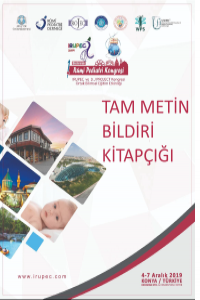Abstract
References
- referans
Abstract
Objective: Visual functions are under-developed in premature infants, as the visual pathways plexus beginning from optic nerves and extending to the visual cortex are affected in parallel with the incomplete myelinization process. Visual Evoked Potential (VEP) is a non-invasive and easily applicable method that provides information about the myelination process. The aim of this paper has been to analyze the evaluation of the VEP results in premature infants, the predictive value and its applicability in clinical practice.
Materials and Method:
Visual evoked potentials (VEPs) refer to the bioelectrical triphasic potentials initiated by flashing light stimulus and recorded by using amplifications and electrodes mounted on the head. It is electrographically based on the measurement of the formation period of the positive wave peak (P100 latency) in terms of milliseconds (ms). In the repeated measurements, as P100 latency gradually shorten; the maturation of visual myelization has been increased at that level. The VEPs tests were performed in our hospital within last 3 years, the premature infants were retrospectively analyzed.
Results:
A total of 197 [102 (51,8%) male, 95 (48,2%) female] premature infants including 75 very preterm, 54 moderately preterm, and 68 late preterm were included in this study. The mean latency (in milliseconds) of P100 wave was 138,94± 21,73; 140,40± 23,85 in the right and left eye respectively. P100 latency was found shorter in the right eye of late preterm as compared to extremely preterm (P:0,04), and in the left eye compared to very preterm and extremely preterm (P:0,02; P:0,03, respectively). P100 latencies of females were found to be shorter as from 18 months of (corrected) age (p: 0.02). In addition, it was seen that late preterm infants approached closer to normal values of P100 latency as compared to others (P> 0.05) after 12 - 18 months of (corrected) age.
Conclusion:
In our study, it was found that visual maturation was better in females; the most prominent maturation began in the period of 3-6 months of (corrected) age, it continued gradually in the following months, and visual maturation generally approached the final adult values by drawing a plateau between 12-18 months of (corrected) age.
Keywords
References
- referans
Details
| Primary Language | English |
|---|---|
| Subjects | Health Care Administration |
| Journal Section | Congress Proceedings |
| Authors | |
| Publication Date | December 10, 2019 |
| Acceptance Date | January 16, 2020 |
| Published in Issue | Year 2019 Volume: 7 Issue: Ek - IRUPEC 2019 Kongresi Tam Metin Bildirileri |


